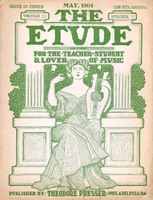L. H.—Kammenoi-Ostrow is a name given to a set or pieces by Rubinstein. It is taken from the name of a fashionable Russian watering-place which Rubinstein used to visit. Each piece of the set is supposed to be a musical portrait or picture of persons the composer met at this place. The favorite is No. 22, which is fully and beautifully described by Mr. Edward Baxter Perry in his “Descriptive Analyses of Piano Compositions.”
P. M. B.—1. The alto, tenor, and bass in four-part harmony depend not upon the soprano note, but upon the chord to be used and also upon the distribution of the notes in the previous chord, and also upon what is possible and good in the succeeding chord. Thus C, which you instance, might be part of the chord C-E-G, F-A-C, A-C-E, F-A-flat-C, C-E-flat-G, A-flat-C-E-flat, or of a dissonance like D-F-sharp-A-C, or E-flat-F-sharp-A-C, etc. You must look to the rules of harmony and counterpoint for an answer to your query as to what the notes for alto, tenor, and bass will be when a certain soprano is given.
2. The “Davidsbündler” was an imaginary association, of Schumann and his friends, banded together against scholasticism and old-fashioned pedantry in music, as David and his men were in league against the Philistines. They contributed articles on music to Schumann’s paper Neue Zeitschrift für Musik (New Journal or Review for Music).
3. Heine was one of the most noted German poets. His little poem “Du bist wie eine blume” (“Thou art like a flower”) has been set to music oftener than any other poem. Jean Paul Richter was a German author who lived 1763-1825. His writings are fantastic in character.
4. A quintet for piano and strings means a composition to be played by a piano, first and second violins, viola, and ‘cello. This does not mean an orchestral selection in which the parts mentioned are played, but a composition written for the five instruments and complete. String quintets are usually written in sonata form.
5. Christoph Willibald Ritter von Gluck is the composer’s full name. The term “Ritter” signifies that Gluck was knighted, and is the equivalent of the English “Sir.”
6. “La Finta Semplice” means a “Simple Trick”; “Re di Ponto” means “King of Pontus”; “Cosi fan Tutti,” “Once for All”; “Tuba Mirum,” “Wonderful Trumpet.” These two words begin one of the verses of the old Latin hymn “Dies Iræ,” “Day of Wrath” or “Judgment,” the verse is:—
“Tuba Mirum spargens sonum,
Per sepulchra regionum,
Coget omnes ante thronum.”
The Episcopal hymnal gives an English version as follows:—
“Wondrous sound the trumpet flingeth;
Through earth’s sepulchres it ringeth;
All before the throne it bringeth.”
7. Wieland was a German poet, 1733-1813.
8. “A fugue on Bach’s name” means that the letters B-A-C-H (used by the Germans to indicate B natural, as B is used for the degree we call B-flat) form the subject or theme upon which the fugue is based.
9. Nicolo Paganini was born at Genoa, October 27, 1782, died at Nice, May 27, 1840.
10. “Der Freischütz” has no direct English equivalent. Literally it means “free marksman”—one who shoots with enchanted bullets.
11. Three-part harmony may be written for any three of the usual four voices, for any combination of male or female voices alone. Only three notes are used in each chord.
R.—1. Heavy chords are played from the shoulder, with the full-arm touch.
2. In any ordinary accompaniment, such as a waltz, the octave or single bass note occurring on the accented beat will be taken with the down-arm, the following chords with the up-arm touch.
3. After a chord has been struck, if it is a soft chord or if it is to be sustained for any length of time, the wrist will naturally fall if the arm is in a properly relaxed condition. If the wrist does not sink, at least slightly, it denotes a contracted condition.
4. Mason’s “Touch and Technic” can and should be used in the early and intermediate grades.
5. During finger work—such as scale passages, etc.—the wrist should be held loosely, but not elevated or unduly depressed. A good rule to follow is that of an imaginary line drawn from the first finger-joint to the elbow. Under certain circumstances, as explained in the answer to your third question, the wrist naturally falls below the level. It is rarely elevated except in certain forte chords and the natural raising of the hand and arm.
6. Melodious teaching pieces ranging in grade from 2 to 5 are to be found in every issue of The Etude.
7. A taste for good music is to be gradually cultivated; it may not be driven. You should proceed cautiously with your pupils. You need not use trashy music, but your pieces should be melodious and attractive. Use bright and interesting studies,—there are many such,—and yet away from the conversional ground. The studies in the “Standard Graded Course” have proved very popular with pupils.
E. H.—In hymn playing, anthem accompaniments, etc., the reed-organ should be played in the same manner as a church- or pipe- organ. That is to say, all repeated notes occurring in the inner voices (alto and tenor) are to be tied and sustained; also all bass notes, except those occurring on a strongly accented beat. Repeated notes occurring in the melody should never be tied. All pieces, of course, must be played as written.



